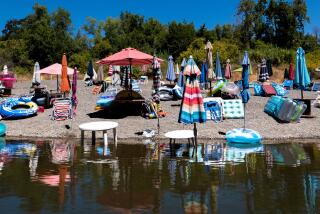Lines in the Sand Over Use of Dunes
- Share via
Thank you for printing “Stark, Bitter Debate Plays Out Over Dunes” (April 15), about the ongoing strife between off-roaders and environmentalists. Off-roaders’ attorney Bill Horn got to the bottom of the debate when he observed that traditional outdoors people don’t want to hear the roar of a dune buggy while they camp. He goes on to claim that this is not a legal basis to limit the use of public property. I beg to differ.
Off-road vehicles are noisy, smelly, leave ugly tracks in nature, contribute to air pollution and threaten the native wildlife with habitat destruction. Public policy states that the public lands are to be used sustainably. With the growing, uncontrolled use of these machines, our natural wild areas are being overrun and quiet areas for city folk to go to for respite from the noise and pressure of the urban environment are becoming scarce.
We’ve got to say no to off-road vehicles now.
Doug Parham
Palmdale
*
As a Californian who enjoys many forms of motorized recreation, I feel that your article stereotypes vehicle users as one and the same. Exploring a remote canyon at Lake Powell on a personal watercraft or riding an all-terrain vehicle in the Imperial Sand Dunes allows me to see more than one could on foot. Motorized recreation is not the reckless and dangerous endeavor portrayed by those who feel public land should be limited to pedestrian access.
The National Forest Service and the Bureau of Land Management have a difficult task in balancing the needs of the different user groups and protecting the environment for future generations. The lawsuits brought by anti-motorized recreation groups have drained the resources of the agencies responsible for governing the land. Litigation, not scientific research, has shaped current land-use policies. Fair evaluation of environmental impact should be done to set guidelines for public land use.
Chuck Welch
La Verne
*
I’m both an off-roader and an environmentalist. I am always amazed at how shortsighted policies can be that open up areas loaded with rare and poorly understood plants and animals. Only recently, gila monster venom was found to contain what may be an antidote to Alzheimer’s; who would think that wiping out something that rare and ugly would have any effect on the human race?
Far too little is known about the biology of the Algodones to allow further destruction with a glib wave of the hand. What a lot of people don’t know is that there are levels of habitat required to sustain many species in any given area. That amount increases exponentially with decreasing resources, such as those found in dune areas. So even if you don’t directly destroy a plant or animal species, if you ruin the area near or around it you may kill off its pollinators or food sources and doom it anyway.
Bill Loy
La Jolla


